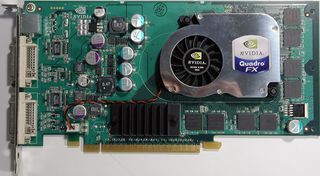NVIDIA, ATi Bring Five OpenGL Workstation Graphics for PCI Express to Market
NVIDIA/PNY Quadro FX 1300

Top right, the NV38GL graphics chip comes with a cooler, while the lower section has an HSI bridge chip to translate PCI Express signals into AGP.
NVIDIA thinks big, and shows off. Even on the Quadro FX 1300, positioned for the lower mid-range category, a tried and tested graphics chip is used. As the last representative of the NV3x generation, processing on the FX 1300 is tackled by the NV38 with its 135 million transistors. So the counterpart in the mainstream sector is the GeForce FX 5950 Ultra. As the NV38GL is actually an AGP chip, NVIDIA has to translate the incoming PCI Express signals with what an HSI bridge chip. That makes this an expensive item. NVIDIA recommends a price of $899/€719 for this card, which is a good $100 more than ATI's FireGL V5100.
The NV38GL matches the NV35 in many respects. For example, both chips house 16 pixel pipelines. NVIDIA is not keen on citing the number of geometry engines, because, according to them, a 'floating-point array' takes over these tasks. To make a rough comparison, this corresponds to three geometry engines.
For memory modules, the manufacturer fits eight Hynix modules with a capacity of 128 MB and an access time of 2.8 nanoseconds. With a clock speed measured at 225 MHz, the DDR modules achieve a theoretical bandwidth of 14.4 gigabytes per second with 256-bit bus width. NVIDIA even claims 17.6 GB/s due to compression techniques. Vertex and Pixel Shader are version 2.0-compatible.
Latest news: At Siggraph, NVIDIA served up a revamped version, the Quadro FX 1400, which offers a memory bandwidth of 19.2 GB/s and SLI.

Standard for the mid-range category: two DVI sockets for analog and digital monitors, and the obligatory connection for 3D glasses.
Stay on the Cutting Edge
Join the experts who read Tom's Hardware for the inside track on enthusiast PC tech news — and have for over 25 years. We'll send breaking news and in-depth reviews of CPUs, GPUs, AI, maker hardware and more straight to your inbox.
Most Popular


